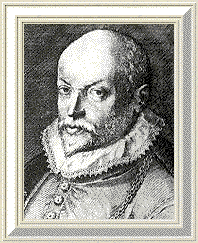 He
served Ferrante Gonzaga of Mantua from circa 1544, accompanying him to
Sicily and Milan (1546-9). He worked for Constantino Castrioto in Naples,
where he probably began to compose, then moved to Rome to join the Archbishop
of Florence's household, becoming "maestro di cappella" of St. John Lateran
in 1553. After returning north, to Mons and Antwerp, where early works
were published (1555-6), he joined the court chapel of Duke Albrecht V
of Bavaria in Munich as a singer (1556). He married in 1558. Although a
Catholic, he took over the court chapel in 1563 and served the duke and
his heir, Wilhelm V, for over 30 years, until his death. In this post he
consolidated his position by having many works published and traveling
frequently (notably to Vienna and Italy, 1574-9), establishing an international
reputation. The pope made him a Knight of the Golden Spur in 1574.
He
served Ferrante Gonzaga of Mantua from circa 1544, accompanying him to
Sicily and Milan (1546-9). He worked for Constantino Castrioto in Naples,
where he probably began to compose, then moved to Rome to join the Archbishop
of Florence's household, becoming "maestro di cappella" of St. John Lateran
in 1553. After returning north, to Mons and Antwerp, where early works
were published (1555-6), he joined the court chapel of Duke Albrecht V
of Bavaria in Munich as a singer (1556). He married in 1558. Although a
Catholic, he took over the court chapel in 1563 and served the duke and
his heir, Wilhelm V, for over 30 years, until his death. In this post he
consolidated his position by having many works published and traveling
frequently (notably to Vienna and Italy, 1574-9), establishing an international
reputation. The pope made him a Knight of the Golden Spur in 1574.
One of the most prolific and versatile of 16th century composers, Lasso wrote over 2000 works in almost every current genre, including masses, motets, psalms, hymns, responsorial Passions and secular pieces in Italian, French and German. Most of his masses are parody masses based on motets, chansons or madrigals by himself or others. The large number of Magnificats is unusual. His motets include didactic pieces, ceremonial works for special occasions, settings of classical texts (some secular e.g. "Prophetiae Sibyllarum," 1600), liturgical items (offertories, antiphons, psalms, e.g. "Psalmi...poenitentiales," 1584) and private devotional pieces. He issued five large volumes of sacred music as "Patrocinium musices" (1573-6), and after his death his sons assembled another ("Magnum opus musicum," 1604).
Admired in their day for their beauty, technical perfection and rhetorical power the motets combine the features of several national styles -
In many ways Orlando di Lasso was very different from Palestrina, with whom his is often linked. Both Lasso's career and his music contrast strongly with those of the Italian composer.